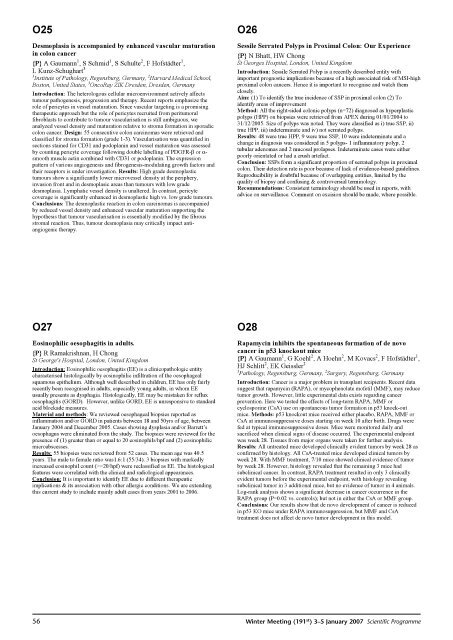2007 Winter Meeting - London - The Pathological Society of Great ...
2007 Winter Meeting - London - The Pathological Society of Great ...
2007 Winter Meeting - London - The Pathological Society of Great ...
- No tags were found...
You also want an ePaper? Increase the reach of your titles
YUMPU automatically turns print PDFs into web optimized ePapers that Google loves.
O25Desmoplasia is accompanied by enhanced vascular maturationin colon cancer{P} A Gaumann 1 , SSchmid 1 , S Schulte 2 , F H<strong>of</strong>städter 1 ,L Kunz-Schughart 31 Institute <strong>of</strong> Pathology, Regensburg, Germany, 2 Harvard Medical School,Boston, United States, 3 OncoRay ZIK Dresden, Dresden, GermanyIntroduction: <strong>The</strong> heterologous cellular microenvironment actively affectstumour pathogenesis, progression and therapy. Recent reports emphasize therole <strong>of</strong> pericytes in vessel maturation. Since vascular targeting is a promisingtherapeutic approach but the role <strong>of</strong> pericytes recruited from peritumoralfibroblasts to contribute to tumour vascularisation is still ambiguous, weanalyzed vessel density and maturation relative to stroma formation in sporadiccolon cancer. Design: 55 consecutive colon carcinomas were retrieved andclassified for stroma formation (grade 1-3). Vascularisation was quantified insections stained for CD31 and podoplanin and vessel maturation was assessedby counting pericyte coverage following double labelling <strong>of</strong> PDGFR-β or α-smooth muscle actin combined with CD31 or podoplanin. <strong>The</strong> expressionpattern <strong>of</strong> various angiogenesis and fibrogenesis-modulating growth factors andtheir receptors is under investigation. Results: High grade desmoplastictumours show a significantly lower microvessel density at the periphery,invasion front and in desmoplasic areas than tumours with low gradedesmoplasia. Lymphatic vessel density is unaltered. In contrast, pericytecoverage is significantly enhanced in desmoplastic high vs. low grade tumours.Conclusions: <strong>The</strong> desmoplastic reaction in colon carcinomas is accompaniedby reduced vessel density and enhanced vascular maturation supporting thehypothesis that tumour vascularisation is essentially modified by the fibrousstromal reaction. Thus, tumour desmoplasia may critically impact antiangiogenictherapy.O26Sessile Serrated Polyps in Proximal Colon: Our Experience{P} N Bhatt, HW ChongSt Georges Hospital, <strong>London</strong>, United KingdomIntroduction: Sessile Serrated Polyp is a recently described entity withimportant prognostic implications because <strong>of</strong> a high associated risk <strong>of</strong> MSI-highproximal colon cancers. Hence it is important to recognise and watch themclosely.Aim: (1) To identify the true incidence <strong>of</strong> SSP in proximal colon (2) Toidentify areas <strong>of</strong> improvementMethod: All the right-sided colonic polyps (n=72) diagnosed as hyperplasticpolyps (HPP) on biopsies were retrieved from APEX during 01/01/2004 to31/12/2005. Size <strong>of</strong> polyps was noted. <strong>The</strong>y were classified as i) true SSP, ii)true HPP, iii) indeterminate and iv) not serrated polyps.Results: 48 were true HPP, 9 were true SSP, 10 were indeterminate and achange in diagnosis was considered in 5 polyps- 1 inflammatory polyp, 2tubular adenomas and 2 mucosal prolapses. Indeterminate cases were eitherpoorly orientated or had a crush artefact.Conclusion: SSPs form a significant proportion <strong>of</strong> serrated polyps in proximalcolon. <strong>The</strong>ir detection rate is poor because <strong>of</strong> lack <strong>of</strong> evidence-based guidelines.Reproducibility is doubtful because <strong>of</strong> overlapping entities, limited by thequality <strong>of</strong> biopsy and confusing & controversial terminology.Recommendations: Consistent terminology should be used in reports, withadvice on surveillance. Comment on excision should be made, where possible.O27Eosinophilic oesophagitis in adults.{P} R Ramakrishnan, H ChongSt George's Hospital, <strong>London</strong>, United KingdomIntroduction: Eosinophilic oesophagitis (EE) is a clinicopathologic entitycharacterised histologically by eosinophilic infiltration <strong>of</strong> the oesophagealsquamous epithelium. Although well described in children, EE has only fairlyrecently been recognised in adults, especially young adults, in whom EEusually presents as dysphagia. Histologically, EE may be mistaken for refluxoesophagitis (GORD). However, unlike GORD, EE is unresponsive to standardacid blockade measures.Material and methods: We reviewed oesophageal biopsies reported asinflammation and/or GORD in patients between 18 and 50yrs <strong>of</strong> age, betweenJanuary 2004 and December 2005. Cases showing dysplasia and/or Barrett’soesophagus were eliminated from the study. <strong>The</strong> biopsies were reviewed for thepresence <strong>of</strong> (1) greater than or equal to 20 eosinophils/hpf and (2) eosinophilicmicroabscesses.Results: 55 biopsies were reviewed from 52 cases. <strong>The</strong> mean age was 40.5years. <strong>The</strong> male to female ratio was1.6:1 (55/34). 3 biopsies with markedlyincreased eosinophil count (>=20/hpf) were reclassified as EE. <strong>The</strong> histologicalfeatures were correlated with the clinical and radiological appearances.Conclusion: It is important to identify EE due to different therapeuticimplications & its association with other allergic conditions. We are extendingthis current study to include mainly adult cases from years 2001 to 2006.O28Rapamycin inhibits the spontaneous formation <strong>of</strong> de novocancer in p53 knockout mice{P} A Gaumann 1 ,GKoehl 2 ,AHoehn 2 , M Kovacs 2 ,FH<strong>of</strong>städter 1 ,HJ Schlitt 2 , EK Geissler 21 Pathology, Regensburg, Germany, 2 Surgery, Regensburg, GermanyIntroduction: Cancer is a major problem in transplant recipients. Recent datasuggest that rapamycin (RAPA), or mycophenolate m<strong>of</strong>etil (MMF), may reducetumor growth. However, little experimental data exists regarding cancerprevention. Here we tested the effects <strong>of</strong> long-term RAPA, MMF orcyclosporine (CsA) use on spontaneous tumor formation in p53 knock-outmice. Methods: p53 knockout mice received either placebo, RAPA, MMF orCsA at immunosuppressive doses starting on week 10 after birth. Drugs werefed at typical immunosuppressive doses. Mice were monitored daily andsacrificed when clinical signs <strong>of</strong> disease occurred. <strong>The</strong> experimental endpointwas week 28. Tissues from major organs were taken for further analysis.Results: All untreated mice developed clinically evident tumors by week 28 asconfirmed by histology. All CsA-treated mice developed clinical tumors byweek 28. With MMF treatment, 7/10 mice showed clinical evidence <strong>of</strong> tumorby week 28. However, histology revealed that the remaining 3 mice hadsubclinical cancer. In contrast, RAPA treatment resulted in only 3 clinicallyevident tumors before the experimental endpoint, with histology revealingsubclinical tumor in 3 additional mice, but no evidence <strong>of</strong> tumor in 4 animals.Log-rank analysis shows a significant decrease in cancer occurrence in theRAPA group (P=0.02 vs. controls); but not in either the CsA or MMF group.Conclusions: Our results show that de novo development <strong>of</strong> cancer is reducedin p53 KO mice under RAPA immunosuppression, but MMF and CsAtreatment does not affect de novo tumor development in this model.56 <strong>Winter</strong> <strong>Meeting</strong> (191 st ) 3–5 January <strong>2007</strong> Scientific Programme













